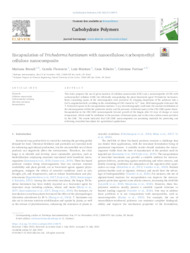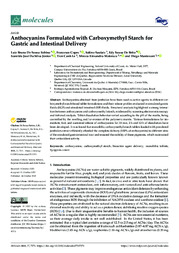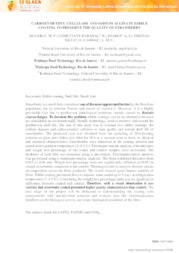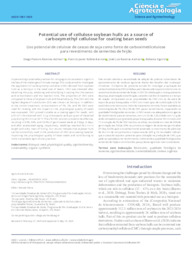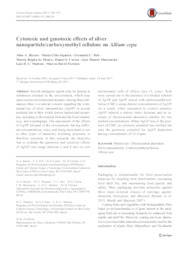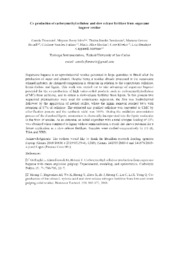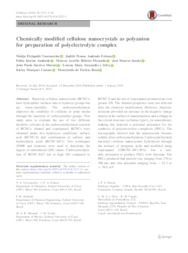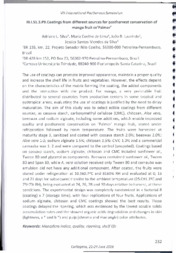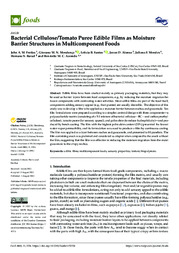Search Publications
Filter by:
| Author(s): BRONDI, M.; FLORENCIO, C.; MATTOSO, L. H. C.; RIBEIRO, C.; FARINAS, C. S. This study proposes the use of green matrices of cellulose nanocrystals (CNC) and a nanocomposite of CNC with carboxymethyl cellulose (CMC) for efficiently encapsulating the plant biocontrol agent Tri... ... |
| Author(s): SABINO, L. B. de S.; COPES, F.; SAULAIS, S.; BRITO, E. S. de; SILVA JÚNIOR, I. J. da; LE, T. C.; MATEESCU, M. A.; MANTOVANI, D. Anthocyanins obtained from jambolan have been used as active agents in different carboxymethyl starch-based tablet formulations and their release profiles evaluated in simulated gastric fluids (SGF) a... ... |
| Author(s): SILVEIRA, M. F. da; COMETTANT-RABANAL, R.; SOARES, A. G.; FREITAS-SILVA, O.; CABRAL, L. M. C. Strawberry is a small fruit considered one of the most appreciated berries by the Brazilian population, for its pleasant flavour and source of vitamin C. However, it is a highly perishable fruit due t... ... |
| Author(s): ASCHERI, D. P. R.; BARROS, P. J. R.; ASCHERI, J. L. R.; SIGNINI, R. Implementing sustainable practices for using agricultural waste is urgent in the face of the challenges of climate change. This study aimed to investigate the application of carboxymethyl cellulose (C... ... |
| Author(s): BECARO, A. A.; SIQUEIRA, M. C.; PUTI, F. C.; MOURA, M. R.; CORREA, D. S.; MARCONCINI, J. M.; MATTOSO, L. H. C.; FERREIRA, M. D.
|
| Co-production of carboxymethyl cellulose and slow-release fertilizer from sugarcane bagasse residue. Author(s): FLORENCIO, C.; SILVA, M. J.; BONDANCIA, T. J.; BRONDI, M. G.; FARINAS, C. S.; MARTINS, M. A.; RIBEIRO, C.; MATTOSO, L. H. C. Sugarcane bagasse is an agro-industrial residue generated in large quantities in Brazil after the production of sugar and ethanol. Despite being a residue already processed in the sugar-cane ethanol i... ... |
| Author(s): VASCONCELOS, N. F.; FEITOSA, J. P. A.; ANDRADE, F. K.; MIRANDA, M. A. R.; SASAKI, J. M.; MORAIS, J. P. S.; SILVA, L. M. A. e; CANUTO, K. M.; ROSA, M. de F. Bacterial cellulose nanocrystals (BCNCs) have hydrophilic surfaces due to hydroxyl groups but are water-insoluble. The carboxymethylation improves the solubility of cellulose in polar media through th... ... |
| Author(s): SILVA, A. L.; LIMA, M. A. C. de; LAURINDO, J. B.; SILVA, J. S. M. da The aim of this study was to select edible coatings from different sources, as cassava starch, carboxymethyl cellulose (CMC), chitosan, Aloe veto, beeswax and sodium alginate, including some additives... ... |
| Author(s): FREITAS, J. A. M.; MENDONÇA, G. M. N.; SANTOS, L. B.; ALONSO, J. D.; MENDES, J. F.; BARUD, H. S.; AZEREDO, H. M. C. de Edible films have been studied mainly as primary packaging materials, but they may be used as barrier layers between food components, e.g., by reducing the moisture migration between components with c... ... |
| Author(s): CASTRO, A. P. C.; TAVARES, P. F. de S.; ARAÚJO, C. P.; PAZ, C. D. da; GAVA, C. A. T. Botryosphaeriacean fungi usually cause mango rot in the tropics. They cause quiescent infections, and symptoms are detectable only in advanced stages of fruit ripening, imposing that control strategie... ... |
Observation
Some of Embrapa's publications are published as ePub files. To read them, use or download one of the following free software options to your computer or mobile device. Android: Google Play Books; IOS: iBooks; Windows and Linux: Calibre.
Access other publications
Access the Agricultural Research Database (BDPA) to consult Embrapa's full library collection and records.
Visit Embrapa Bookstore to purchase books and other publications sold by Embrapa.

